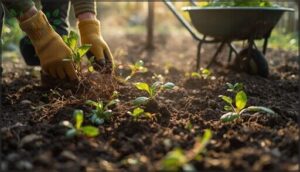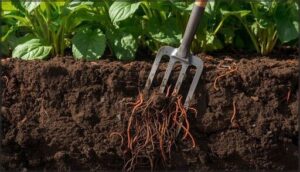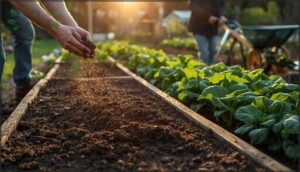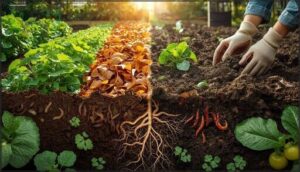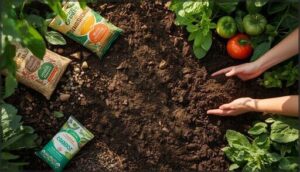This site is supported by our readers. We may earn a commission, at no cost to you, if you purchase through links.

You can spot tired garden soil by the way plants struggle to thrive—patchy growth here, stunted leaves there, water pooling after a rain instead of soaking in. Even the richest beds lose their spark over time, especially if roots have been fighting through hard, compacted earth or nutrients have been drained season after season.
Renewing vegetable garden soil isn’t guesswork; it’s about reading the subtle signs, understanding what your soil is telling you, and bringing it back to life with tried-and-true methods. A healthy, productive garden starts from the ground up—literally. Let’s dig into what makes soil truly ready for the season ahead.
Table Of Contents
Key Takeaways
- Tired soil shows itself with uneven plant growth, poor drainage, and a compacted texture that restricts healthy roots.
- Restoring soil health begins with clearing debris, loosening compacted layers, and blending compost and native soil for balance.
- Regular use of organic amendments like compost, manure, biochar, and cover crops boosts fertility and sustains soil life.
- Keeping soil healthy year-round requires mulching, crop rotation, annual testing, and precise fertilization for lasting results.
Signs Your Garden Soil Needs Renewal
Your garden soil works hard season after season, and sometimes it runs out of steam. When your plants struggle despite your best efforts, the problem often lies beneath the surface.
Even the hardest-working garden soil eventually gets tired, making healthy plants impossible no matter how much care you give
Here’s how to recognize when your soil needs a refresh so you can bring it back to life.
Identifying Depleted or Compacted Soil
How do you know when your soil’s in trouble? Watch for uneven plant growth—what farmers call “tall corn, short corn syndrome”—which signals compaction beneath the surface. Check roots; if they’re stubby and shallow instead of deep, your soil structure needs help.
One common issue is reduced water infiltration, a key symptom of soil compaction. Use a wire probe: if it bends before reaching four inches, bulk density is restricting growth. Water runoff instead of absorption confirms the problem, indicating it’s time for a soil test.
Recognizing Poor Drainage and Water Retention
Beyond compaction, poor drainage tells its own story. Standing water lingering more than 48 hours puts your plants at serious risk—over 40% higher crop losses in waterlogged conditions. Look for soil mottling: rusty, grey, or bluish streaks that appear in 68% of poorly drained gardens. Addressing commercial landscape drainage can prevent these issues.
These aeration issues starve soil organisms and compromise root health, disrupting the soil structure your vegetables depend on.
Assessing Soil Color, Texture, and Smell
Your senses reveal more than you might expect. Soil color indicators show that darker soils—those with Munsell values below 4—hold considerably more organic carbon. Crumble a handful to assess texture: sandy soils drain fast but starve roots, while clay-heavy mixes suffocate them. A rich, earthy smell signals thriving soil biology. Together, these sensory testing methods deliver surprisingly accurate soil quality readings:
- Dark brown to black coloration marks fertile, carbon-rich beds
- Crumbly, granular texture means excellent aeration and structure
- Fresh, earthy aroma confirms active microbial communities working for you
Gray or mottled patches? That’s your cue to renew.
Using Soil Testing Kits for Nutrient and PH Analysis
While your senses offer clues, soil testing kits deliver precision. Home kits like LaMotte achieve 94% accuracy against lab results, measuring pH level, nitrogen, phosphorus, and potassium for $15 to $750 per hundred samples.
Regular soil test adoption has boosted yields by up to 30% through data-driven fertilization. Check nutrient availability and pH annually—kit accuracy pays off in healthier plants and smarter spending.
Essential Steps to Renew Vegetable Garden Soil
Once you’ve spotted the warning signs, it’s time to roll up your sleeves and get to work. Renewing your garden soil doesn’t have to be complicated, but following the right sequence makes all the difference.
Let’s walk through the key steps that’ll bring your tired soil back to life.
Removing Old Plant Debris and Weeds
Your soil won’t recover properly until you clear away last season’s plant debris and weeds.
This garden maintenance step is important for pest disease prevention—decomposing plant material can harbor fungal diseases and overwintering pests that threaten next year’s crops.
Pull or mow down weeds before they add to weed seedbanks, then consider debris composting in a hot pile to recycle nutrients safely.
Aerating and Loosening Compacted Soil
Once you’ve cleared debris, compacted soil needs breaking up to let oxygen, water, and roots move freely again. Use a garden fork or plug aerator to create holes 4–6 inches apart and deep—this simple aeration timing after debris removal can improve root growth by up to 25%.
Even encouraging earthworm activity loosens soil naturally, boosting porosity by 40% over time.
Incorporating Native Soil for Structure
After loosening your garden soil, mixing native soil back in brings real benefits—local microbes, minerals, and a texture that holds together without packing down. Studies show native soil integration boosts soil respiration by up to 25%, supporting stronger root systems and nutrient cycling.
Here’s how to incorporate it effectively:
- Blend one-third compost with two-thirds native soil for ideal structure and drainage
- Mix to a depth of 8–10 inches using a garden fork to preserve fungal networks
- Add native soil as a base layer in raised beds for microbial establishment
- Avoid excessive tilling to protect delicate soil biology
- Pair with native plants to improve root channels and natural aeration
This approach cuts fertilizer needs while improving water infiltration by 15–20%, creating resilient garden soil that works with your local environment rather than against it.
Timing Soil Renewal for Best Results
Think of soil renewal like tuning an engine—timing is everything for a smooth season ahead. Spring soil prep prepares beds before planting, while fall compost timing rebuilds organic matter after harvest. Don’t skip a mid-season boost for heavy feeders or an annual soil test to track progress.
| Task | Best Timing | Key Benefit |
|---|---|---|
| Soil Preparation | Early Spring | Peak nutrient uptake |
| Compost Amendment | Post-Harvest | Restores soil health |
| Soil Test | Yearly | Guides amendments |
Organic Amendments for Soil Rejuvenation
Bringing life back to tired soil starts with the right organic amendments. Each option has its own strengths for building healthy ground beneath your vegetables.
Here’s what you can use to give your garden soil the boost it needs.
Applying Homemade Compost and Livestock Manure
Ever wondered what gives your plants a real leg up? Homemade compost and well-cured manure are powerhouses—delivering a steady nutrient profile that matches most garden needs.
Applied at recommended rates, these soil amendments improve soil structure, boost organic matter, and naturally manage pathogens.
Regular use means healthier soil, better water retention, and measurable gains in crop yield year after year.
Using Biochar for Improved Fertility and Microbe Support
Biochar benefits your soil in more ways than one—think of it as giving your garden a network of tiny houses for microbes. Its porous structure improves soil properties, boosts organic matter, and sets the stage for lively microbial activity.
Regular use increases crop yields and helps trap carbon, making biochar a smart choice for sustainable, long-term soil amendments.
Adding Leaf Mold as Mulch and Conditioner
Leaf mold works wonders for moisture retention and soil structure, acting as both garden mulch and conditioner. When you spread a 2–3 inch layer over your beds, it fosters organic matter, suppresses weeds, and cuts disease problems.
Its nutrient composition aids steady growth, while compost-like qualities help prevent soil depletion and encourage healthier, more resilient plants all season long.
Integrating Green Manures and Cover Crops
Just as leaf mold builds resilience, green manures and cover crops take soil rejuvenation a step further. Sowing a cover crop after harvest or before spring planting boosts organic matter, aids nitrogen fixation, and preps your beds for the next round.
With regular use, these practices encourage stronger soil structure, better moisture retention, and healthier crop rotation outcomes year after year.
Maintaining Soil Health Year-Round
Keeping your garden’s soil healthy isn’t a one-time job—it’s something you pay attention to all year. There are a few key habits that make a real difference in how your soil performs.
Here’s what you’ll want to focus on as the seasons change.
Regular Mulching for Moisture and Weed Control
Almost every season, applying garden mulch brings real mulch benefits—weed suppression and better soil moisture stand out. A deep mulching method with organic mulches like wood chips or straw slows evaporation, cuts your watering needs, and keeps weeds at bay.
Mulch layering, alongside composting and mulching, boosts garden efficiency while protecting soil from compaction and harsh weather.
Monitoring Soil Health and Organic Matter Levels
Mulch keeps moisture steady, but real soil health means keeping tabs on organic matter and biology year-round. A simple soil test reveals pH, nutrient cycling, and organic matter—aim for above 4% for top yields. Counting earthworms or sniffing for that earthy scent tells you Soil Microbes are thriving, driving carbon sequestration and soil quality.
- Track organic matter with annual soil testing
- Observe earthworm activity for soil biology clues
- Watch infiltration rates for healthy nutrient cycling
Practicing Crop Rotation for Nutrient Balance
When you rotate crops, you’re not just mixing things up—you’re boosting nutrient cycling and soil health for sustainable gardening. By planning crop families and using legumes for nitrogen fixation, you build yield increase stability and soil microbial diversity.
Here’s a quick guide to crop rotation planning:
| Rotation Cycle Length | Benefit |
|---|---|
| 3 Years | Pest suppression |
| 4 Years | Yield stability |
| Legume Year | Nitrogen fixation |
| Diverse Families | Microbial diversity |
| Balanced Nutrients | Soil fertility |
Annual Fertilization and Compost Application Guidelines
Before spring planting, aim for 1 inch of compost—any more risks phosphorus buildup. Split nitrogen fertilizer: half before planting, half as plants grow. If your soil’s organic matter tops 4%, skip extra nitrogen.
Regular monitoring of nutrient levels keeps your soil structure strong and maintains healthy nutrient cycling. Well-timed applications boost yields and help you reach organic matter targets.
Top Products for Renewing Garden Soil
Choosing the right products can make renewing your garden soil much easier. There are a few trusted options that gardeners rely on for better results.
Here’s a look at some top picks to help you get started.
1. The Vegetable Gardening Book by Lamp’l
Ever wondered how some gardens seem to thrive year after year, bursting with life and flavor? Lamp’l’s Approach in The Vegetable Gardening Book lays out the science and art of Soil Renewal, weaving together Organic Methods, Crop Rotation, and smart Garden Design.
You’ll find practical guides for boosting Soil Health—like increasing Organic Matter and using Compost—with clear steps grounded in Soil Science. Lamp’l’s advice helps you improve soil structure, fertility, and resilience, making Soil Improvement accessible for gardeners at any skill level.
Best For: Anyone who wants to grow a productive, organic vegetable garden—whether you’re a beginner or have years of experience.
- Covers everything from seed starting to advanced soil renewal, all with clear, practical steps.
- Features detailed growing guides for 40 popular crops, plus handy charts and templates.
- Focuses on organic, sustainable methods that build healthy, resilient gardens over time.
- Sticks closely to organic gardening, so it may not suit those interested in conventional methods.
- The book’s size and weight make it less convenient to carry around the garden.
- Some readers may find it tricky to quickly locate specific info due to the layout.
2. Espoma Organic Bone Meal Plant Food
Looking to boost root strength and flowering in your vegetable garden? Espoma Organic Bone Meal delivers long-lasting Phosphorus benefits, with an NPK ratio of 4-12-0 and 12% calcium for sturdy roots.
Application rates run 1–2 pounds per 100 square feet, worked into the topsoil for steady plant nutrition. It’s OMRI-certified, safe for pets, and made without fillers—so you get pure organic matter for soil improvement.
Plus, its slow release enhances soil structure and health while minimizing environmental impact from fertilizers.
Best For: Gardeners who want an organic, pet-safe way to boost root growth and flowering in vegetables, bulbs, and flowers.
- Certified organic and safe for pets and kids
- High phosphorus and calcium for strong roots and blooms
- Improves soil health and structure over time
- May attract dogs, so pets should be kept away after application
- Can be dusty to apply on windy days
- Not ideal for soils that already have high phosphorus levels
3. Espoma Rock Phosphate Organic Plant Food
Wondering how to tackle stubborn Phosphorus Deficiency without compromising your Organic Certification? Espoma Rock Phosphate Organic Plant Food steps up with a pelletized, low-dust formula—safe for pets and wildlife.
With just 3% immediately available phosphorus and a total of 24%, it’s ideal for slow-release plant nutrition, especially in acidic soils.
Apply 2.5 lbs per 100 square feet after a soil test confirms need. Its gentle Environmental Impact and boost to organic matter make it a smart choice for balanced soil pH.
Best For: Gardeners and organic growers who need to correct phosphorus-deficient soils without sacrificing organic standards or environmental safety.
- All-natural, OMRI-listed formula safe for pets, people, and wildlife
- Pelletized for easy, low-dust application and even soil coverage
- Supports strong root growth, flowering, and increased yields in vegetables
- Only 3% of phosphorus is immediately available to plants in the first season
- Not suitable for soils that already have high phosphorus levels
- May require additional fertilizers for a complete nutrient balance
Frequently Asked Questions (FAQs)
How can I safely use wood ash in the garden?
Curious if wood ash truly benefits your garden? Used wisely, wood ash offers a boost through pH adjustment and mineral balancing.
Stick to safe ash sources, monitor plant sensitivity, and always verify with a soil test before application.
Is solarizing soil effective for weed and disease control?
Solarizing soil delivers excellent weed control and disease suppression by using high Solarization Temperatures to disrupt pests, boost Soil Fertility, and create healthier Soil Organisms—making it a reliable, research-backed Soil Improvement Technique for gardeners.
Are earthworms a reliable indicator of healthy soil?
Earthworms are a trusted earthworm soil indicator, signaling strong soil ecology and healthy biology. Their abundance boosts microbial diversity and fosters plant growth.
Additionally, earthworms facilitate pollution detection, reflecting rich worm castings and balanced chemical properties for genuine soil health and fertility.
What role do soil microbes play in fertility?
Just as a team works better with diverse skills, soil fertility thrives on microbial diversity impact.
Microbes drive microbial nutrient cycling, stabilize soil structure, balance soil pH, and foster strong vegetable yields—essential threads in the tapestry of soil science.
Conclusion
Like a chef who sharpens his knives before every meal, a gardener who cares for the soul of their soil gives roots their best chance. The process of renewing vegetable garden soil is more art than obligation, a gentle collaboration with nature.
Over time, your hands learn to sense what the earth truly needs. Healthy soil, once tired, bounces back—carrying hope, vigor, and future harvests.
Every season, richer than the last, begins from beneath your boots.
- https://cmg.extension.colostate.edu/Gardennotes/711.pdf
- https://farmonaut.com/blogs/best-organic-compost-manure-for-vegetable-garden-2026
- https://www.timwallacesoilmixsupply.com/how-often-should-you-amend-the-soil-in-your-vegetable-flower-and-shrub-gardens/
- https://agsci.oregonstate.edu/oregon-vegetables/soil-acidity-important-factor-vegetable-yields
- https://pmc.ncbi.nlm.nih.gov/articles/PMC10969708/

